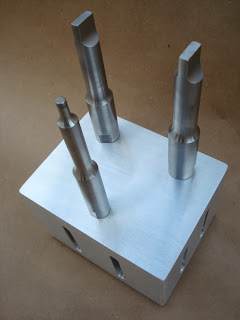Industrial Ultrasonics, Inc was contacted by a major mattress manufacturer who was experiencing issues with their ultrasonic welding application (sealing non-woven material for individually wrapped coil spring mattresses). The two main issues were: 1) Uneven amplitude across the face of the horn was causing a weak weld at both ends of the seal area and 2) The horns were cracking and had to be replaced at an unacceptable rate of 7 or more per year. Note: The ultrasonic horns that were giving the mattress manufacturer problems were being purchased directly from the OEM which supplied their ultrasonic welding equipment.
Our customer's existing horn design was analyzed using FEA (Finite Element Analysis) software. As you can see in Figure 1 - Original Horn, there is adequate amplitude in the center portion of the working face (as represented by the dark red area), but the amplitude decreases at either end of the working face (as represented by the light red & pink areas).
 |
| Figure 1 - Original Ultrasonic Horn |
The ultrasonic horn was redesigned utilizing FEA design software. As you can see in Figure 2 - Redesigned Ultrasonic Horn, the amplitude is now evenly distributed across the entire face. Also, the stress was reduced by 21% in the areas where the horns had typically been cracking.
 |
| Figure 2 - Redesigned Ultrasonic Horn |
In addition to the huge savings experienced via reduced tooling costs and down time, the mattress manufacture was also able to increase production due to reduced weld cycle times.
Disclaimer: Keith Anderson of Industrial Ultrasonics, Inc designs and manufactures ultrasonic welding horns for use on all brands of ultrasonic welders including, but not limited to, Branson, Dukane, Forward Technologies, Herrmann, Rinco, Sonobond, and Stapla. Please visit us at www.industrialultrasonics.com for more information.




